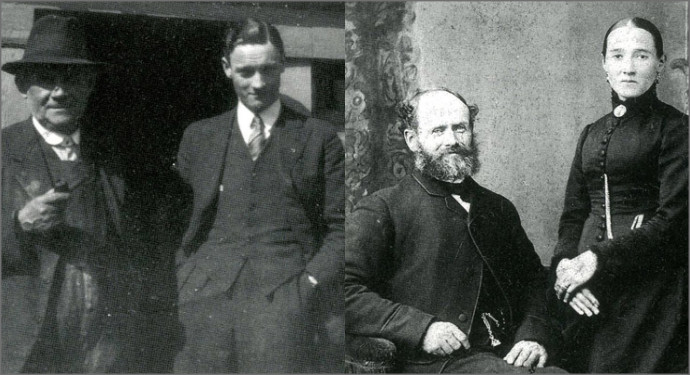Our History
After serving his apprenticeship as a monumental mason in Aberdeen, followed by a period of seasonal working in Barre, Vermont, USA, Alexander Robertson returned home in 1876, and with savings he had earned from working in the States, joined forces with another mason, Mr Gray, and set up their own stonecutters business. The Robertson and Gray partnership worked out of St Clair Street, which ran between King Street and West North Street, Aberdeen.
In 1876 there were 37 different granite firms. Most of these firms were made from short lived and ever changing partnerships. Like most other partnerships, Robertson and Gray did not last. In 1878 Alexander Robertson continued business on his own, based at 259 King Street on the corner of St Clair Street. Sixty years later in 1936, when Alexander’s grand-son Sandy entered the business, the firm still occupied this corner site. By the end of this decade, the firm had grown and Alexander rented a second yard in St Clair Street, employed a number of operatives, and had customers throughout Scotland and the North of England.

After only 10 successful years in business, Alexander died suddenly in 1886, at the age of 45. His son George, at the age of 25 took over the responsibility of running the business, with his second wife Jane inheriting ownership of the other half. The company changed its name from Alex Robertson, to Alex Robertson & Son.
The three surviving sons of Alexander Robertson’s second marriage, Norman, William and John, joined their stepbrother and learned about the industry. They all served their time in the family business. When they had completed their respective apprenticeships, Norman set up his own business in Falkirk, retailing gravestones, using the family firm as his supplier. William and John remained with George.
In 1897, a consortium of granite merchants set up the Granite Supply Association Ltd. Its main purpose was to supplement the local supply of granite by importing a wide variety of granites from abroad. This gave the local industry, now consisting of around 70 firms, a consistently fair price for imported blocks. and a wider variety of coloured granites to chose from.
In 1905, George, like his father before him, died comparatively young. He left his share of the business to his stepmother Jane Robertson, who became its sole owner. With her eldest son Norman already in business by himself, she gave the responsibility of managing the business to her second eldest son, William, aged 24.
William bought over the business from his mother in 1928. The period between 1929 and 1931 saw many granite firms go out of business. Competition was severe and by 1936, William had only two employees, both family. His brother John was the lettercutter and Norman’s brother-in-law, Bill Burnett, was the mason. They were one of the smallest of Aberdeen’s 68 granite firms and had considerable debts.
This was the year William’s eldest son Alexander (Sandy) joined the family firm. A high achiever at school, Sandy entered the family business against the wishes of his mother. She was sure he could make a better life for himself away from the failing business, which appeared to have no prospects for the future. Sandy’s younger brother Bill left school and joined the family firm in 1938. In 1939 when Sandy was drafted to serve in the Second World War, Bill took over Sandy’s job, until he too was called up in 1941.
During the war William bought the photographer’s studio of WL Dunn & Co next door at 273 King Street. This was back-to-back with the masons shed at 271 King Street and would become the new lettering shed. Within a few years the firm employed three masons, two lettercutters and two apprentice lettercutters.
By the end of 1950 the firm had a healthy bank balance and no debts. Sandy Robertson commented “The firm’s cash was now kept entirely separate from our own and my father and I drew our wages and nothing else.” (Morgan;2001)
William Robertson died in 1958 at the age of 77. Sandy had effectively been in charge of the day to day running of the firm since his return home after the war, and was therefore well equipped to head the family business on his father's death. He soon realised that in order to survive in the ever increasingly competitive international granite market, not only would they have to expand the business, but also they would have to consider joining forces with other local granite firms.
In 1960, the company opened up their first branch in the small town of Buckie. One of the main competitors in Aberdeen at that time was a company called James Robertson & Son, of 393 Hardgate (no relation). The son, Bill Robertson, was keen to go into partnership with Sandy over the purchase of Buckie. Although Sandy preferred to embark on the Buckie venture by himself, two years later in 1962, both firms began talks of amalgamation again. On 1st March 1963, Alex Robertson & Sons merged with James Robertson & Son, and adopted the new name of A & J Robertson (Granite) Ltd.
After a period of ill health, Bill Robertson took early retirement on 30th June 1978, leaving Sandy Robertson as sole chairman and managing director. Sandy's son Graeme had joined the company in 1974 as a trainee manager, and joined the board of directors in 1978.
At the end of 1983, the Aberdeen Granite Association was wound up. It had shrunk to just two members, A & J Robertson (Granite) Ltd and John Fyfe Ltd. Robertson by then embraced eight firms, the two Robertsons, the two Taggarts, Edwards, Caie & Co, Kemp & Co and Crofts & Sons. As McLaren wrote: It was 'a far cry from the heyday of an industry consisting of 90 yards employing 1881 men and boys-1606 journeymen, 275 apprentices.
On 10th January 1984 Graeme was appointed joint managing director with his father who remained chairman. Sandy retired from full time work in 1989 and Graeme was appointed sole managing director. In 1999 when his father retired as non-executive chairman, Graeme became chairman and managing director of the firm.
Between 1978 and 1990 a further seventeen firms across the UK were acquired, including in 1987 Robertson acquiring a 40% interest in Harold Stevenson's long established family firm in Burnley. His nephew Brent Stevenson became a director of Robertson and, still based in Burnley, sat on the board of directors until a period of ill health in 1996. Brent resigned from the board of directors and sold his shares in the company back to Robertson. In return, Robertson sold three branches to Brent at Blackburn, Colne and Oswaldtwistle. Brent Stevenson remains a trade customer of Robertson today.
Over the last twenty years, Robertson's retail expansion has not increased, focusing instead on expanding it's trade customer base. Whilst it now has twenty eight retail branches in various parts of the UK, it priorities its sales to repeat customers within the trade.
In autumn 2015 an agreement was reached to sell the Pittodrie yards owned by Robertson to be developed for student accommodation. The proceeds of this sale allowed Robertson to acquire a 1.25 acre site at Westhill, on the outskirts of Aberdeen, and to construct a new head office, factory with new machinery and equipment and yard. The new premises at Silvertrees were moved into on 15th May 2017.
The Board of Directors consists of:
- Graeme Robertson – Chairman & Managing Director
- Cliff Alexander - Management Accountant
- Neil Robertson – Trade Sales Director
- Stewart Gibson – Retail Sales Director
- Tony Jack - Factory Director
- Bob Hutcheson - Non-Executive Director

Request a brochure
We have two beautifully printed, full colour memorial brochures. One to suit Scottish cemeteries and the other to suit English and Welsh cemeteries. We can post directly to your door – or you can download the Scottish pdf version with price list here and the English and Welsh pdf version with price list here.